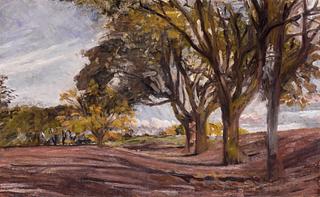Albert Gottschalk (1866–1906)
Chestnut Avenue at the Hermitage, 1905?
Oil on canvas
42 x 68.3 cm
Inventory number B 302
Albert Gottschalk found his motifs all over Denmark, and he was unafraid to focus on lesser-known locations. Most often, however, he turned to places located on the outskirts of Copenhagen, where he lived, or in North Zealand, where he often came to find inspiration. Chestnut Avenue at the Hermitage is believed to be one of his last paintings from Dyrehaven, which he repeatedly visited to paint over a period of several years.1
Four tall trees lead the eye diagonally into the picture from the right. The long shadows run almost parallel to the lower edge. The reddish-brown foreground is painted by means of unusually long, unbroken brushstrokes, a contrast to the short strokes seen in the crowns of the trees. In the centre of the picture, past the avenue and the distant group of trees, rose-coloured clouds form a pronounced contrast to the green meadow and the surrounding treetops with their hues of yellow and brown.
Chestnut Avenue at the Hermitage testifies to Gottschalk’s talent as a painter and colourist. Despite his gifts, Gottschalk sold very few paintings during his lifetime. Many found his works too sketch-like and unfinished, which meant that they struggled to recognise them as ‘proper’ works of art.2
Most of the paintings by Gottschalk that C.L. David incorporated into his collection were acquired in 1949. These are mainly late works from the artist’s hand, as five out of the total of six works were created during the last six years of Gottschalk’s short life.
Four tall trees lead the eye diagonally into the picture from the right. The long shadows run almost parallel to the lower edge. The reddish-brown foreground is painted by means of unusually long, unbroken brushstrokes, a contrast to the short strokes seen in the crowns of the trees. In the centre of the picture, past the avenue and the distant group of trees, rose-coloured clouds form a pronounced contrast to the green meadow and the surrounding treetops with their hues of yellow and brown.
Chestnut Avenue at the Hermitage testifies to Gottschalk’s talent as a painter and colourist. Despite his gifts, Gottschalk sold very few paintings during his lifetime. Many found his works too sketch-like and unfinished, which meant that they struggled to recognise them as ‘proper’ works of art.2
Most of the paintings by Gottschalk that C.L. David incorporated into his collection were acquired in 1949. These are mainly late works from the artist’s hand, as five out of the total of six works were created during the last six years of Gottschalk’s short life.
Published in
Published in
Albert Gottschalk, født i Stege 3. Juli 1866, død i København 13. Februar 1906, Den Frie Udstilling, Oktober 1930, København 1930, cat.no. 242, p. 32;
Erik Zahle: ”Malerisamlingens vækst” in C.L. Davids Samling, Tredje del, København 1958, pp. 128, 168-169;
C.L. David: C.L. Davids Samling, København 1960, p. 24;
Troels Andersen: Albert Gottschalk: 1866-1906, 2. rev. ed., Valby 2013, cat.no. 364, p. 176;
Troels Andersen in Kjeld von Folsach and Nana Lund (eds.): Dansk kunst i Davids Samling – fra Philipsen til Saxbo, København 1995, cat.no. 64, pp. 156-157;
Gertrud Oelsner (ed.): I maleriets udkant - Albert Gottschalk (1866-1906) = Men denna eftermiddag = But this afternoon, Storstrøms Kunstmuseum and Faaborg Museum, Maribo 2002, cat.no. 73, pl. 42, p. 121;
Erik Zahle: ”Malerisamlingens vækst” in C.L. Davids Samling, Tredje del, København 1958, pp. 128, 168-169;
C.L. David: C.L. Davids Samling, København 1960, p. 24;
Troels Andersen: Albert Gottschalk: 1866-1906, 2. rev. ed., Valby 2013, cat.no. 364, p. 176;
Troels Andersen in Kjeld von Folsach and Nana Lund (eds.): Dansk kunst i Davids Samling – fra Philipsen til Saxbo, København 1995, cat.no. 64, pp. 156-157;
Gertrud Oelsner (ed.): I maleriets udkant - Albert Gottschalk (1866-1906) = Men denna eftermiddag = But this afternoon, Storstrøms Kunstmuseum and Faaborg Museum, Maribo 2002, cat.no. 73, pl. 42, p. 121;
Footnotes
Footnotes
1.
Troels Andersen: Albert Gottschalk, Sophienholm, Kgs. Lyngby, Viborg 1988, pp. 6–7.
2.
Troels Andersen has pointed out that Chestnut Avenue at the Hermitage might be identical with the painting known by the title Large, Free-standing Trees. Autumn from 1900 according to the list of exhibited works at Albert Gottschalk’s memorial exhibition at the Kunstforeningen in Copenhagen in 1906, cat. no. 148.
Paintings and drawings
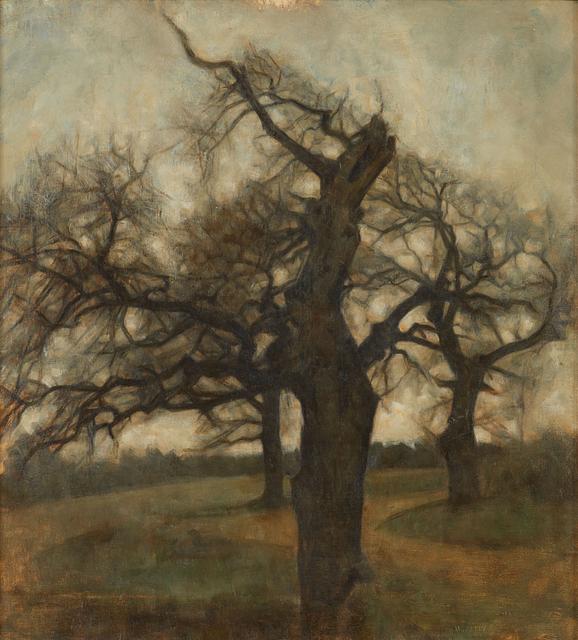
Svend Hammershøi (1873–1948)
Oak Trees near Vordingborg, 1917
Oil on canvas
Oak Trees near Vordingborg, 1917
Oil on canvas
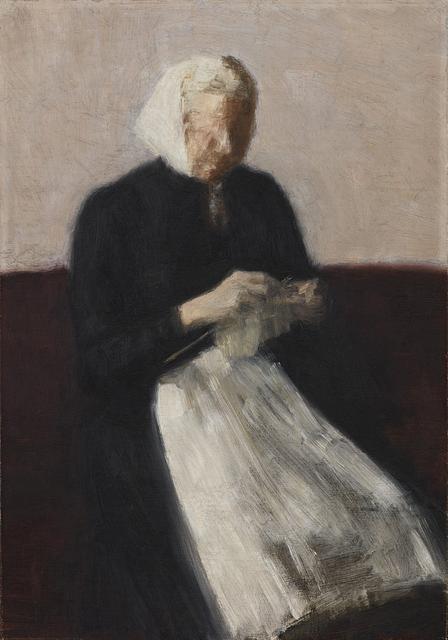
Vilhelm Hammershøi (1864–1916)
Woman Knitting. The Artist’s Mother, 1889
Oil on canvas
Woman Knitting. The Artist’s Mother, 1889
Oil on canvas
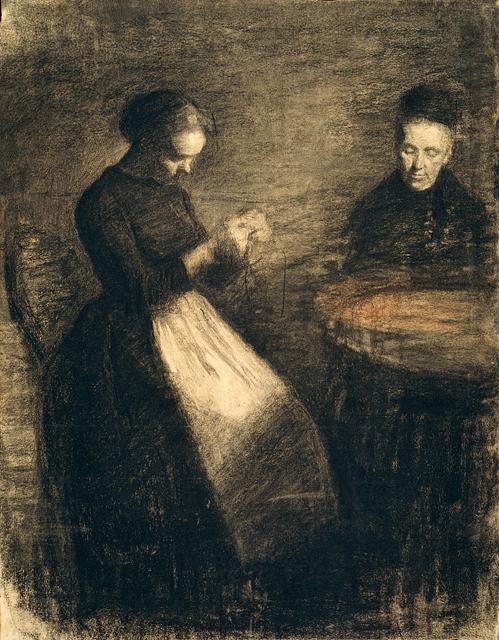
Vilhelm Hammershøi (1864–1916)
Evening in the Drawing Room. Two Women at a Round Table, 1891
Lead and chalk on paper
Evening in the Drawing Room. Two Women at a Round Table, 1891
Lead and chalk on paper
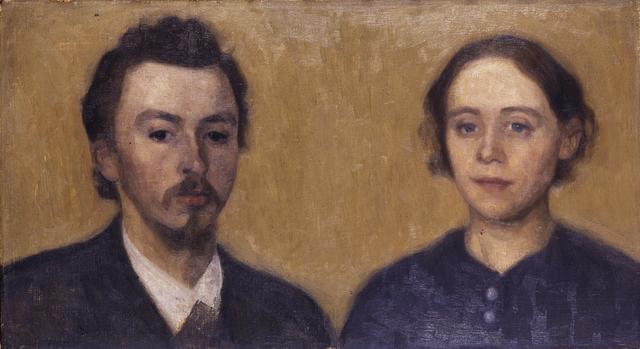
Vilhelm Hammershøi (1984–1916)
Double Portrait of the Artist and his Wife, 1892
Oil on canvas
Double Portrait of the Artist and his Wife, 1892
Oil on canvas
